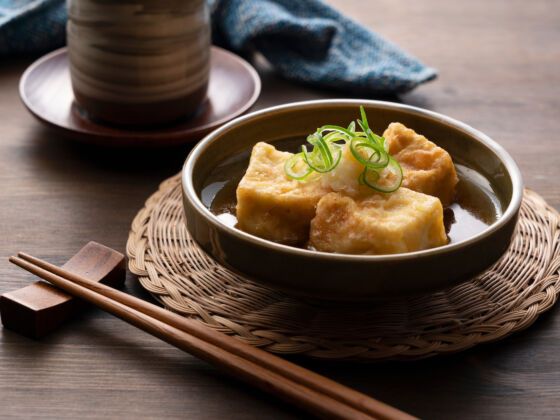From the long existing tradition of Shojin ryori, or vegetarian monk’s cooking, comes a variety of soy products to keep you healthy and well fed. For a budget traveler, soy products are generally cheap, high in protein, and cholesterol free, leaving you with vim and vigor for sightseeing.


An Essential Guide to Tofu in Japan for Vegetarians, Foodies, and Travelers
Tofu: A Primer
Tofu is made by boiling freshly squeezed soymilk, and adding a coagulant which transforms the milky fluid into blocks. Tofu, like wine, is believed to differ in flavor depending on where it’s made in Japan—Kyoto is known to have the best, as their water is considered the tastiest. Try to get the tofu from a neighborhood tofu shop if you can, as the goodies are made freshly on the premises, rewarding you with flavors that are difficult to replicate from a supermarket.
Sukui dofu: Sukui means to scoop, and this ultra soft silky tofu is so delicate it requires a spoon for eating. Its beauty lies in its simplicity—all it really needs is a dash of soy sauce and some freshly grated ginger.
Kinugoshi dofu: a slightly firmer tofu compared to the sukui dofu, this is the one you may have seen in small cubes, floating in your breakfast miso soup. Momen dofu is the firmer variety which holds together better for stir frying .
Flavored tofu: If you still find the silkiest of all tofu to be unappealingly bland and boring, try the egg tofu, a yellow tofu that tastes like a salty flan. The shiso, or Japanese basil, and yuzu (Japanese lime) are my favorites, but the goma, or sesame tofu is just as delicious.
Fried tofu
When tofu is fried, its texture becomes chewy, and it looks and taste completely different from its original form.
Ganmodoki: These fried tofu and vegetable balls are the tastiest when nibbled piping hot, out of an oil stained paper bag. It’s commonly enjoyed in stewed and braised dishes such as oden or nimono.
Aburaage: You may have seen these at the sushi take out counter in the form of inari sushi, or fried tofu pouches stuffed with rice. Aburaage is made by deep frying tofu slices until the skin becomes blistered and chewy, and its color as golden as a fox’s coat—don’t be alarmed if you see kitsune udon on the menu at a noodle shop, as it refers to the aburaage, and not the fuzzy critter.
Tofu’s edible by-products
During the tofu making process, nothing goes to waste, and the by-products of tofu such as okara and yuba are also treated with dignity, as opposed to ending in heaps in a compost pile.
Yuba: This is the skin that forms atop boiling soymilk, which is harvested and rolled into sheets. In Kyoto, yuba dishes are widely popular, often eaten in clear soups or braised, and there are restaurants which specialize in yuba cuisine. Don’t waste your time reconstituting the dry stuff as the fresh variety is softer and less rubbery.
Okara: Okara’s fiber content tends to be rather high, so consume it sparingly, especially so before a romantic evening. When all traces of soy milk have been sucked out of the pulverized, boiled soy beans, you’ve got okara–on its own, it’s bland, crumbly and dry, in need of major flavor, but this humble by-product is tasty when stewed in a soy sauce broth with vegetables as a side dish.
For those with a sweet tooth, scope out the Japanese health food shops for their sinful okara butter cookies and cakes.
The coagulant
Magnesium chloride, that compound used to de-ice highways in winter, is also the magic ingredient that turns boiling soy milk into blocks of firm tofu.
Nigari : If you’ve been considering Botox, lipo, or Rogaine, try some Nigari –the Japanese believe that this extremely bitter elixir has plenty of minerals to keep you svelte and young. The commercial nigari drinks are made palatable by adding fruit juice. For a nigari spa experience, pop some nigari supplements, and slather yourself with nigari beauty products while lying under the shade of a blossoming Sakura tree.
The milk of tofu
Tounyu, or soymilk: If you’ve been traumatized by the funky after taste of western soymilk, try the Japanese varieties, sold in small carton boxes at any supermarket. The Kibun brand has been around for a while, with flavors such as sesame, malt coffee, matcha, banana and chocolate.
Absolutely worth a try is their sweetened chestnut, or marron flavor, designed to mimic the taste of a French Mont Blanc pastry. For a sweet treat to conclude your soy adventure, indulge in some tounyu flan, which had won over many of my soy reluctant family members.
Community Connection
If you travel to eat, take a look at eating and traveling slow in Italy. Vegan? Check out the ultimate vegan’s guide to finding food on the road. If you’re planning a trip to Asia, read up on dog meat and rooster balls. And, if you just plain believe in the connections between food and place, try tasting place.